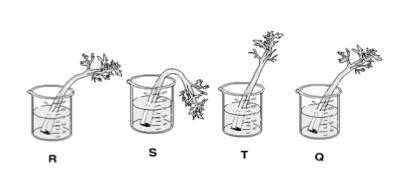
Biology, 07.03.2021 09:10 Davynsurfsoccergirl
The picture shows a turgor pressure demonstration using stalks of celery in different salt solutions. Which of these shows the celery stalks in order from the one with the most turgor pressure to the one with the least turgor pressure?
Group of answer choices
T, Q,R, S
Q, T,S, R
Q, R,S, T
S, R,Q, T


Answers: 1


Another question on Biology

Biology, 21.06.2019 17:40
4the indian leaf butterfly has traits that allow it to resemble a leaf. the bright colors of the monarch butterfly indicate that the butterfly tastes bad and can be poisonous. how does the appearance of these butterflies them to survive? f the indian leaf butterfly is able to avoid predators while the monarch butterfly warns predators away. g. the indian leaf butterfly frightens predators away while the monarch butterfly poisons predators before they can eat it. h both butterflies rely on camouflage to avoid predation. j both butterflies cooperate with one another to avoid predation.
Answers: 1

Biology, 21.06.2019 19:30
Name the following: (a) category of pathogen that causes diseases, like common cold and mumps. (b) the microorganism that requires a host to produce.
Answers: 2

Biology, 22.06.2019 01:30
Scenario 5 1) take 10 red and 10 black beans and place them, mixed, on the table. record the starting phenotype # and frequencies (% of your total population) of your starting population in the table provided (generation 0). 2) act as a predator. “capture” as many organisms as you can until you have reduced the population to three organisms. put them aside. at this point, the predators die. 3) the remaining organisms each produce 2 clonal offspring. multiply your organisms accordingly and allow them to mix on the table. calculate and record the resultant phenotype # and frequencies (% of your total population) of your population in the table provided (generation 1). 4) repeat the reproduction event, allowing each of your organisms to produce 2 clonal offspring. calculate and record the resultant phenotype # and frequencies (% of your total population) of your population in the table provided (generation 2). 5) repeat the reproduction event, allowing each of your organisms to produce 2 clonal offspring. calculate and record the resultant phenotype # and frequencies (% of your total population) of your population in the table provided (generation 3).
Answers: 1

Biology, 22.06.2019 03:00
Aboy jumps into a cold swimming pool and his body tempature goes down hus muscles ,blood vessels
Answers: 1
You know the right answer?
The picture shows a turgor pressure demonstration using stalks of celery in different salt solutions...
Questions

Biology, 09.01.2020 01:31



Mathematics, 09.01.2020 01:31

Mathematics, 09.01.2020 01:31




Mathematics, 09.01.2020 01:31



Health, 09.01.2020 01:31


Geography, 09.01.2020 01:31

Mathematics, 09.01.2020 01:31




Mathematics, 09.01.2020 01:31




